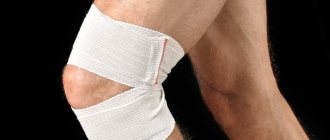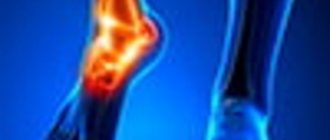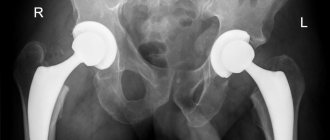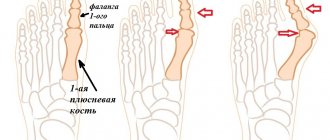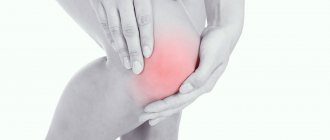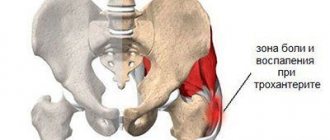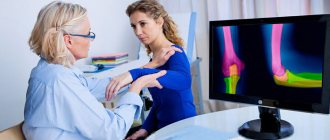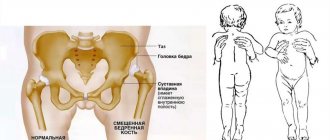The causes of hip pain can be very diverse. The article identifies several of them.
Pain in a person can have different etiologies and forms. Discomfort in the thigh area usually occurs acutely and suddenly. The pain appears either in the upper part of the leg and radiates to the groin, or it hurts severely under the knee or even “shoots” in the foot.
- The hip area hurts equally in men and women.
- For each person, the causes of discomfort may be different and they always have anatomical or physiological characteristics.
- Let's take a closer look at the causes of this disease and treatment methods.
Causes of hip pain
Pain in the femur
Pain in the hip bone can occur for various reasons. The main etiology of this disease is as follows:
- Injury after a sharp blow due to a fall or other factors . Often such damage occurs in athletes or in people whose activities involve heavy work.
- Damage to the femoral neck . Old people suffer from this disease. Especially in women during menopause, when hormonal imbalances lead to brittle bones - osteoporosis. A fracture can occur after an accidental fall, for example, on a slippery road or when a person trips while walking up the stairs.
- Fracture of the sacrum. Pain can also occur as a result of damage to the pelvic or pubic bone. In this case, it is necessary to take an x-ray to make a correct diagnosis.
- Injury to the first lumbar vertebral disc . May appear after a fall from a great height onto the gluteal muscles.
- Various bruises of the pelvic bones.
- Stretching of muscle tissue and ligaments in the thigh area. In old people after 60-65 years of age, this occurs from wear and thinning of muscle tissue, and in young guys or girls - after difficult physical exercise.
- Inflammation in the hip joint sac . It occurs with redness of the epidermal layer, swelling appears and the temperature rises.
- Vascular disorders in the iliac region . Pain in the lower abdomen may appear from thrombosis of the artery that “lies” in this area of the body.
- Infectious diseases, endocrinopathy, osteomyelitis.
Pain in the femur can appear after hard work, injuries, falls, illnesses, changes in muscles and joint tissues. If the discomfort is not treated, the condition may worsen, and the discomfort will become progressive.
Important: Only a doctor can make a correct diagnosis. Do not self-medicate - it is dangerous to your health! Treatment should only be prescribed by a doctor.
Below we will look at painful conditions that appear in many people. When should you call the emergency room, and when should you rush to consult a doctor?
What does hip pain when walking indicate?
Pain in the femoral area when moving
The most unpleasant pain appears when performing motor movements: walking or even lying on the bed, when a person tries to roll over from one side to the other. Modern people live at a frantic pace, and when unpleasant sensations interfere with movement, this is a problem. Discomfort when walking occurs for the following reasons:
- A hip fracture is one of the most difficult fractures. Acute painful sensations appear. The person needs urgent hospitalization and treatment under the supervision of a doctor.
- Sprains, bruises and other injuries . When walking, any injury will be felt more strongly. When moving, discomfort may manifest itself with painful pulsation - increasing or pulling.
- Arthritis and arthrosis initially manifest themselves only in the form of discomfort during physical activity. After standing on your feet for a long period of time, fatigue and an unpleasant aching pain appear.
- Bursitis at the very beginning also manifests itself more strongly with physical activity. After standing on your feet for a long time, the discomfort can be very burning and unpleasant.
In any of these cases, you need to urgently go to the clinic. If the discomfort is acute and unbearable, then it is better to call emergency help. It is always timely hospitalization and early treatment that helps to quickly cope with the disease and avoid health problems.
Causes of hip and groin pain
Pain in the femur and groin area
This symptom in the form of aches in the groin and thigh appears with the following ailments:
- Coxarthrosis . This disease occurs with a feeling of discomfort in the groin area and thighs. Discomfort increases over the course of a month and does not go away. Constant pain makes it difficult to feel confident. A strong painful sensation appears when walking in the groin area. You may not feel this sensation at rest, but when you move, it makes itself felt again.
- Aseptic necrosis of the bone head . The symptoms of this disease are similar to the symptoms of the previous illness, but the pain increases with double force over a couple of days - quickly and unbearably.
- Arthritis - if the disease is not cured in time, then it can manifest itself as painful impulses that radiate to different parts of the body, including the groin area. Discomfort with arthritis can occur at any time of the day, regardless of physical activity or stress.
If the pain is aching or “burning,” then it is not necessary to call the emergency room. But, if there is obvious discomfort in the groin area, which is permanent and becomes unbearable, you should urgently seek help from a doctor. This may be a symptom of other diseases that are more dangerous to health than, for example, arthritis or arthrosis.
Pain in the leg from the hip to the knee or to the foot: causes
Pain in the leg from the femur to the knee or to the foot.
If a discomforting ache begins in the area of the femur or even the lumbar region, passes through the entire lower limb to the knee or foot, and ends with shooting pain in the lower leg, interfering with walking, this is osteochondrosis or a hernia in the leg. lower back.
The vertebrae become pinched, inflammation begins and the painful feeling increases every day. In this case, the aches can be aching, burning or shooting through the entire limb.
Causes of pain in the right and left thigh
Pain in the right and left thigh
The area of discomfort may indicate the root cause of the condition. If pain occurs on the right or only on the left, then the problem may be hidden in the lumbar region, hip joint tissues or legs.
Symmetrical pain - simultaneously in the femur on the right and left, indicates ailments in the central nervous system, brain, as well as diabetes mellitus. This may also indicate varicose veins, an autoimmune disorder, or the presence of a tumor.
Important: To find out about the true source of such an illness, you need to consult a highly specialized doctor for diagnosis and prescription of treatment procedures.
Pain in the hip joint: causes
Pain in the joint tissues of the hip
The hip joint tissues are the largest bones in humans. There are many reasons why the femur may be bothering you, but they can be divided into 3 main groups:
- Physiological changes in joint tissue that may appear after injury or congenital pathological processes (dislocation, etc.). Deviation of the head of the femoral bone can provoke a disease that chronically disrupts the correct position of the leg during gait (flat feet, club feet, and others).
- Pathologies in the joint sac and soft muscle tissue of this area (injury to the leg or joint, inflammatory processes, degenerative changes).
- Impaired functioning of other organs , which manifest as discomfort in the hip joint. A person may feel that the hip bone ache due to inflammation of the nerve root and disturbance in the back, buttocks or groin area.
Accordingly, in newborn children, discomfort will be caused by congenital pathology, and in people after 60-70 years old, bone-destroying arthrosis will cause discomfort. Also, the hip joint can suffer, causing discomfort, from the following diseases:
- arthritis
- bursitis
- rheumatism
- synovitis
- tendinitis
- various injuries to muscles and ligaments
- injury to the articular head
If inflammation in the pelvis (neuritis, radiculitis, various muscle syndromes) is not treated in a timely manner, then discomfort can be expressed in the form of pain in the hip joint.
Types of pain radiating to the leg
Pain in the hip joint radiating to the leg can occur suddenly and be pronounced or increase slowly and gradually. Depending on this, the doctor suggests what kind of disease we are talking about.
(if the table is not completely visible, scroll to the right)
| Type of pain | Characteristic |
| Acute | It is short-term in nature. Its source is easy to determine. This is a signal about the onset of illness or injury. Initially, the pain is localized in one specific place (most often in the hip joint itself), and as surrounding tissues become involved in the pathological process, it gradually spreads to other parts of the leg. Easily treatable. People suffering from acute pain often seek medical help. |
| Aching | It is often a consequence of acute pain, does not have a clear localization, occupies a significant area of the leg (for example, the entire front or back surface), and is periodic in nature. Determining the source of this type of pain is quite difficult, which makes treatment difficult. |
| Chronic | This is pain radiating to the leg, which lasts more than six months. This is the most difficult type of pain to diagnose and treat, since most often it indicates advanced disease and may even require surgical treatment. Typically, it is chronic pain in the hip joint that radiates to the leg, since most joint diseases develop gradually and in the initial stages do not bother a person much. |
Pain radiates to the thigh: causes
Pain radiates to the femoral area
As mentioned above, pain in the femur can occur not only in cases where changes occur in the articular cartilage itself and the tissues located near them, but also when problems arise in other organs and systems.
- For example, an intervertebral hernia of the lower back often manifests itself as pain in the femoral region - on the side or in front. This is one of the main criteria for the symptoms of this disease.
- In the presence of such a hernia, pain is felt only in one leg. The discomfort may be mild or intolerable. It all depends on the complexity of the process.
- In addition, discomfort in the thigh area can be combined with discomfort in the groin, lower leg or even foot.
- Numbness in these areas of the body is also characteristic.
There are many nuances to such painful sensations, and only a doctor can correctly diagnose the disease and prescribe medications for recovery.
What does nagging and aching pain in the hip indicate?
Drawing and aching pain in the thigh
This pain appears with pathologies located within or around the joint. There is a small space around the joint filled with a small amount of synovial fluid. With its help, the bones of the joint glide well and do not experience friction.
Any disease or injury causes the amount of this fluid to increase. In addition, even blood can get into the joint space. The joint capsule begins to stretch and a nagging or aching pain appears. Also, nagging or aching pain can appear with the following pathologies:
Pathologies
All these pathologies occur with nagging pain, but in order to forget about this or that ailment forever, it is necessary to correctly diagnose and prescribe treatment procedures. For example, in Roth-Bernhardt disease with cutaneous neuralgia, the joint is not damaged. In this case, treatment should be aimed at getting rid of discomfort and the factors causing this pathology.
Three main pathologies that cause pain and their treatment
Arthritis of the hip joint
The disease is more common in old age.
A characteristic symptom is severe aching pain in the hip joint.
When only joint structures are involved in inflammation, the discomfort is localized within the joint itself.
If discomfort begins to spread along the front surface of the thigh up to the knee, this indicates the transition of inflammation to the periarticular structures. In this case, when walking and moving the leg, sharp acute pain attacks occur with shooting pain in the front of the thigh. Gradually, stiffness of movements joins the pain syndrome.
Treatment
Main methods of therapy:
- hormonal and anti-inflammatory drugs;
- exercise therapy, massage and physiotherapy courses.
Coxarthrosis – arthrosis of the hip joint
Click on photo to enlarge
Typically, this pathology is diagnosed in people aged 40–60 years. It is characterized by an imperceptible onset, with vague pain sensations on only one side (in the right or left hip joint). The pain symptom practically subsides during rest and appears only in the joint during loading.
As the intra-articular cartilage tissue is destroyed, the severity of the pain increases, it becomes constant, and it radiates into the leg due to compression and pinching of the ligaments and nerve bundles. By this time, they can become unbearable when trying to perform any movement, which results in shooting in the groin and knee.
Treatment
Conservative treatment is effective only at stages 1 and 2 of the disease. To do this, the rheumatologist selects a course of therapy, which includes: chondroprotectors, NSAIDs, painkillers, exercise therapy and massage.
In later stages, joint replacement surgery is indicated.
Bursitis
Hip bursitis is an inflammation of the joint capsules.
There are two possible courses of the disease:
- Vertical bursitis, in which pain radiates to the leg along the lateral surface of the thigh.
- Ischiogluteal bursitis, when the pain symptom becomes especially acute when trying to sit down.
Bursitis is characterized by cramping pain deep in the tissues. The patient cannot lie on the affected side, as the discomfort immediately increases. With this pathology, the pain is never limited to just the joint - it always radiates to the leg.
Treatment
A course of injection therapy with NSAIDs together with corticosteroids and restriction of mobility is effective.
What does pain in the thigh muscles mean?
Pain in the muscle tissue of the thigh
Discomfort in the muscle tissue appears under heavy loads or when the muscles themselves are torn or stretched. But more often the problem is hidden not in the muscle layer, but in the joints that are “hidden” behind this area. Therefore, the factors behind the appearance of this condition can be very different, and to establish a diagnosis, you should see a doctor.
All patients need to know that muscle pain is often simply reflected. For example, with piriformis syndrome, when a person suddenly lifts weights or makes an unsuccessful movement, his lower back ache for several days, and only then discomfort appears in the soft tissues of the thigh and buttocks.
Seven causes of pain in the hip joint with kickback to the leg
- Injuries;
- arthritis;
- arthrosis;
- inadequate blood supply to joint segments;
- infections;
- a change in the normal anatomy of the joint, when, as a result of dislocation or subluxation (congenital or acquired), the head of the femur occupies an incorrect position in the acetabulum;
- diseases of other organs and systems, when joint pain radiating to the leg occurs against the background of neurological disorders: lumbar radiculitis, sciatic nerve neuritis and piriformis syndrome.
Hip dislocation
Causes of pain in the hips and buttocks
Pain in the hips and buttocks
The buttock is a muscle with a layer of subcutaneous fat. Simultaneous pain in the thigh and buttock can occur after injury or during inflammatory pathological stages. A person may also feel discomfort that is transmitted from the sacrum, coccyx or spine. If there are problems, then it may seem that the buttock ache. Here's how a person might experience pain and what it means:
Discomfort in the right thigh and buttock:
- An unpleasant ache may appear after heavy physical work.
- Such sensations can also be caused by disorders in the knee, groin or spine.
- Discomfort intensifies during the day, increases before bedtime and disappears completely in the morning.
- Then the symptoms reappear.
- In this case, you need to check the spine in the lumbar region for the presence of a hernia.
Discomfort when sitting:
- When aching occurs when sitting or lying on one side, the body “speaks” about the occurrence of such an ailment as trochanteric bursitis.
- Such discomfort may also appear as a result of damage to the spinal cord root, pathology of muscle cells in the gluteal region, or radiculitis.
All these health problems can be easily treated, but they are dangerous due to their complications. It is important to visit a doctor in a timely manner for diagnosis and treatment.
general description
Pain in the pelvis on the right or left is often complemented by an inflammatory process, pinching of the sciatic nerve or its irritation. In such a situation, the aching pain often spreads to the leg, thigh and buttocks. It becomes more pronounced during physical activity and when performing certain loads.
Painful sensations appear from the thigh and tailbone, spread to the muscles of the buttock, to the back of the thigh and calves, and radiate to the foot, without moving to the phalanges of the fingers. Pain is felt throughout the entire limb. Most often, this unpleasant symptom affects only one lower limb. In some cases, sciatica occurs on both limbs.
When pain occurs, especially if it lasts for a long time, the general condition of the body suffers, and a person’s gait changes. He tries to reduce the load on the diseased limb by transferring it to the healthy one. This is how lameness occurs.
Which doctor should I contact for hip pain?
An orthopedic doctor treats hip pain.
First, you need to make an appointment with a general practitioner - this is a general practitioner who refers the patient to a highly specialized doctor. The therapist can also write out referrals for tests to get an initial picture of a possible disease.
An orthopedist treats ailments related to bones and joints . For a complete picture of the disease, the following is prescribed:
- X-ray of the pelvis
- CT scan of the pelvis
- MRI of bones and tissues of the pelvis
After receiving the diagnostic results, the doctor will make a diagnosis and prescribe medications. Medications are often prescribed; surgery is not always necessary.
Diagnosis of pain in the leg closer to the groin
Joint pain cannot be ignored. Any unpleasant sensations indicate a violation of the functionality of the body and pathology of the internal organs. Contact KDS Clinic. Experienced specialists will provide assistance at any time. The patient is sent for tests and a comprehensive examination of the body. With such symptoms, the patient should undergo an X-ray of the joints and ultrasound diagnostics. General tests will show details of the body's internal indicators. To get a more accurate result, it is worth doing magnetic resonance imaging. The procedure is prohibited for pregnant women, women during the lactation period and children under sixteen years of age. Consult your doctor before undergoing the examination.
Make an appointment with a specialist by number. In some cases, the patient is left in the hospital to monitor improvements in indicators. We suggest that you familiarize yourself with prices for all services on the official website of the medical institution.
Treatment for hip pain
If you experience hip pain, do the following:
- Stop physical activity . If discomfort appears after physical work, then you need to rest so that the muscles relax. If after rest the pain subsides, and after resuming physical activity it reappears, then you should consult a doctor.
- Lie down . If unpleasant sensations appear as a result of compression of the spinal nerves, then in a horizontal position of the body, the load on the vertebrae decreases, the distance between them increases and the pain weakens.
- Light massage in the thigh area . Stroking movements in the thigh area will help relieve pain from injury, but massage is ineffective when nerves and blood vessels are damaged. But remember that you should not intensively massage the painful area, as this can cause harm.
- Apply cold to the area of inflammation . This method helps with bruises and sprains. Cold reduces the sensitivity of nerve endings, and this helps reduce discomfort.
If hip pain is accompanied by inflammation, then it is necessary to take medications that inhibit the activity of inflammation, reducing the severity of pain. Here is a list of drugs that are used depending on the severity of the disease and its etiology:
List of medications that can help relieve hip pain
REMEMBER: Only a doctor should prescribe medications! Self-medication is life-threatening!
In addition to drug therapy and painkillers, massage, physiotherapy, therapeutic exercises and, in some cases, surgical treatment in the form of endoprosthetics, arthroplasty, and so on are prescribed.
Treatment of pain in the hip joints
Therapy is prescribed by a doctor after a pre-established diagnosis. For the drug treatment of hip joint diseases, the following scheme is used:
- Non-steroidal anti-inflammatory drugs. Their main goal is to relieve an acute inflammatory process, reduce the severity of pain, and eliminate swelling. Such medications include Indomethacin, Ibuprofen, Dicrofenac.
- Muscle relaxants. Designed to eliminate muscle spasms and relieve pinched sciatic nerves. Such drugs include Movalis, Tolperil, Meloxicam.
- Glucocorticosteroids. Designed to relieve inflammation and relieve pain. This is Prednisolone, Dexamethasone.
- Chondroprotectors. The task of these drugs is to restore damaged cartilage structures. These are Artra, Chondroxil, Chondroitin Glucosamine, Theraflex.
- Vitamin complexes – Milgamma, Neurobeks.
If conservative treatment is ineffective, surgery may be used. At an advanced stage of diseases of the articular apparatus of the hip area, joint replacement is performed, which consists of completely replacing the damaged part of the hip. After such treatment, rehabilitation is carried out. Its result is relief from pain and unpleasant symptoms that arise during the development of degenerative diseases.
With proper and timely treatment, diseases of the hip joint that are accompanied by severe pain can be cured.
